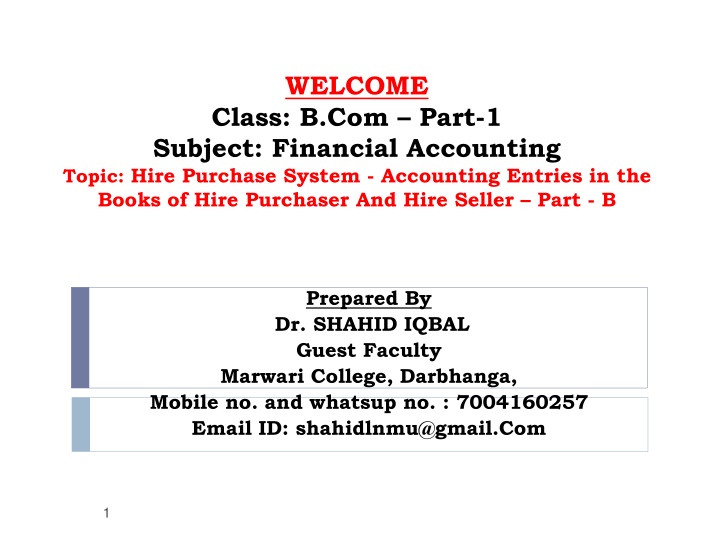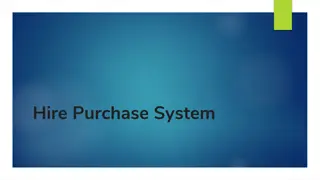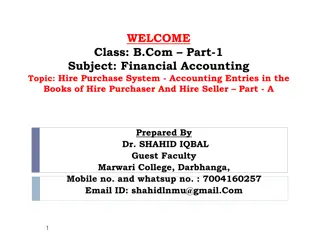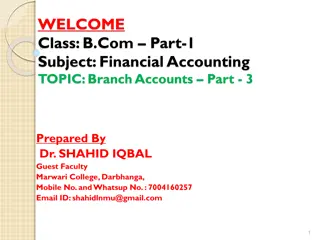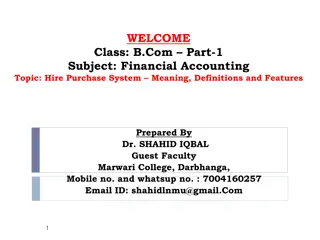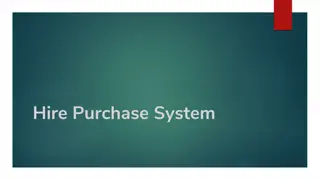Accounting Entries in Hire Purchase System for Credit Purchase with Interest Method
In the Credit Purchase with Interest Method of Hire Purchase System, assets acquired on hire purchase basis are treated as acquired on outright credit basis with interest. This method involves initial entries for recording the asset acquisition, down payments, interest on outstanding balance, installment payments, depreciation charges, and end-of-year transfers. Entries are made to account for cash prices, payments made to hire vendors, interest, depreciation, and profit and loss transfers. The method follows a structured approach to manage hire purchase transactions efficiently.
Download Presentation

Please find below an Image/Link to download the presentation.
The content on the website is provided AS IS for your information and personal use only. It may not be sold, licensed, or shared on other websites without obtaining consent from the author.If you encounter any issues during the download, it is possible that the publisher has removed the file from their server.
You are allowed to download the files provided on this website for personal or commercial use, subject to the condition that they are used lawfully. All files are the property of their respective owners.
The content on the website is provided AS IS for your information and personal use only. It may not be sold, licensed, or shared on other websites without obtaining consent from the author.
E N D
Presentation Transcript
WELCOME Class: B.Com Part-1 Subject: Financial Accounting Topic: Hire Purchase System - Accounting Entries in the Books of Hire Purchaser And Hire Seller Part - B Prepared By Dr. SHAHID IQBAL Guest Faculty Marwari College, Darbhanga, Mobile no. and whatsup no. : 7004160257 Email ID: shahidlnmu@gmail.Com 1
I (B) Credit Purchase with Interest Method: This method considers the assets acquired on hire purchase basis as acquired on outright credit basis with interest. Therefore, on the date of signing the hire purchase agreement, the asset acquired is debited to Asset A/c with cash price and Hire Seller s A/c is credited in the books of the hire purchaser. The important features of this method are as follows. 1. As the asset acquired (on hire purchase basis) is considered as acquired on outright credit basis, cash purchase price (of the assets) is debited to the Asset A/c crediting Hire Seller s A/c on the date of signing the hire purchase agreement. 2. Down payment made, if any, at the time of signing hire purchase agreement is considered as a payment made to the hire vendor on account. Hence, an entry debiting Hire Seller s A/c and crediting Bank/Cash A/c is passed. 2
3. Interest on the outstanding balance of the cash price of the asset acquired is brought into 4. book, at the end of each installment, by debiting Interest A/c and crediting Hire Seller s A/c. 5. Each installment paid is treated as a payment made to the hire vendor on account by 6. debiting Hire Seller s A/c and crediting Bank/Cash A/c. 7. Depreciation computed on the basis of cash price of asset is charged annually (accounting year) by debiting Depreciation A/c and crediting the Asset A/c. 8. At the end of each accounting year, both the interest and depreciation are transferred to the Profit and Loss A/c by debiting Profit and Loss A/c, and crediting Interest A/c and Depreciation A/c. 3
In the light of the above introduction, an analysis of entries for hire purchase transactions under Credit Purchase with Interest Method is made below. (1) For recording the asset acquired on hire purchase basis, the following entry is passed for the cash price of the asset so acquired and this entry is passed on the date of signing the hire purchase agreement. Asset A/c To Hire Seller s A/c (Being the cash price of the asset acquired on hire purchase basis) Dr. (2) For recording the down payment made, if any, the following entry is passed. It may be noted here that the down payment is made to hire seller on account. Hire Seller s A/c To Bank/Cash A/c (Being the amount of down payment made) Dr. 4
For the purpose of recording the installment amount paid, the procedure differs (as under Asset Accrual Method) from annual installments to half-yearly, quarterly, etc. In the case of annual installments, the following four entries are passed at the end of each of the annual installments. (3) For recording the amount of installment interest due to the hire vendor, the following entry is passed. Interest A/c To Hire Seller s A/c (Being the amount of installment interest due) Dr. (4) For recording the payment of installment amount to the hire vendor, the following entry is passed. Hire Seller s A/c To Bank/Cash A/c (Being the amount of installment paid) Dr. 5
(5) For recording the depreciation on the asset, the following entry is passed at the end of the year. Depreciation A/c To Asset A/c (Being the amount of depreciation charge) Dr. (6) For transferring the amounts of interest and depreciation to the Profit and Loss A/c, the following entry is passed at the end of the accounting year. Profit and Loss A/c To Interest A/c To Depreciation A/c (Being the amounts of interest and depreciation transferred to Profit and Loss A/c) Dr. 6
On the other hand, if the installments are paid more frequently such as half-yearly, quarterly, etc., then, the following two entries (for installment interest amount due and for payment of installment amount) are passed at the end of each of the installments (except the last installment for the accounting year). (7) For recording the amount of installment interest due to the hire vendor, the following entry is passed. Interest A/c To Hire Seller s A/c (Being the amount of installment interest due) Dr. (8) For recording the payment of installment amount to the hire vendor, the following entry is passed. Hire Seller s A/c To Bank/Cash A/c (Being the amount of installment paid) Dr. 7
Besides, at the end of the last installment for the accounting year, all the four entries (as required for annual installment) are passed as reproduced below. (9) For recording the amount of last installment interest due (for the accounting year) to the hire vendor, the following entry is passed. Interest A/c To Hire Seller s A/c (Being the amount of installment interest due) Dr. (10) For recording the payment of last installment amount (for the accounting year) to the hire vendor, the following entry is passed. Hire Seller s A/c To Bank/Cash A/c (Being the amount of installment paid) Dr. 8
(11) For recording the depreciation on the asset for the whole accounting year, the following entry is passed at the end of the year. Depreciation A/c To Asset A/c (Being the amount of depreciation charge) Dr. (12) For transferring the amounts of interest and depreciation (for the entire accounting year) to the Profit and Loss A/c, the following entry is passed at the end of the year. Profit and Loss A/c To Interest A/c To Depreciation A/c (Being the amounts of interest and depreciation transferred to Profit and Loss A/c) Dr. 9
Thank You 10
